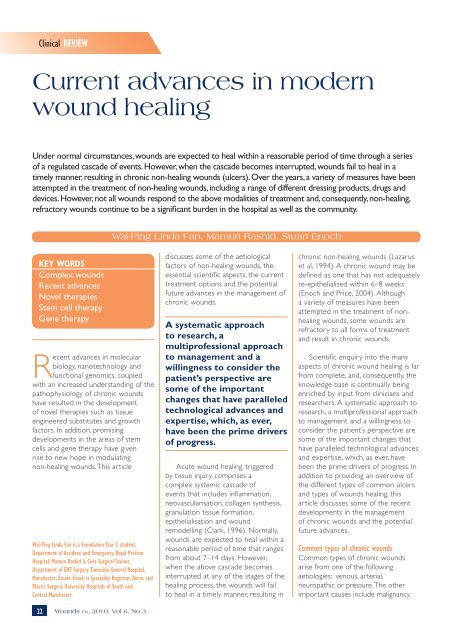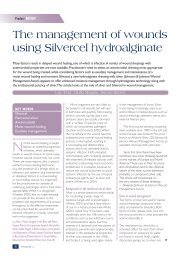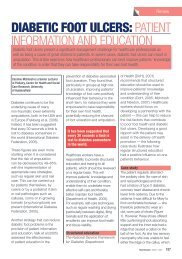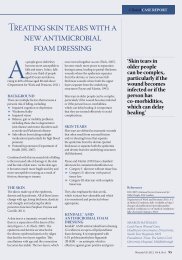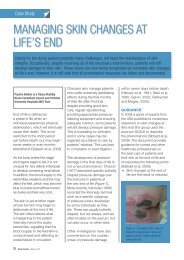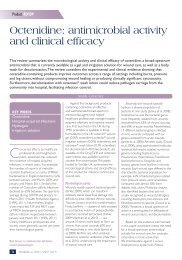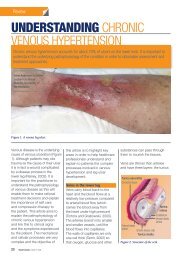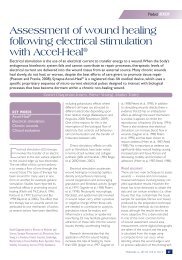Current advances in modern wound healing - Wounds UK
Current advances in modern wound healing - Wounds UK
Current advances in modern wound healing - Wounds UK
- No tags were found...
Create successful ePaper yourself
Turn your PDF publications into a flip-book with our unique Google optimized e-Paper software.
Cl<strong>in</strong>ical REVIEW<br />
<strong>Current</strong> <strong>advances</strong> <strong>in</strong> <strong>modern</strong><br />
<strong>wound</strong> heal<strong>in</strong>g<br />
Under normal circumstances, <strong>wound</strong>s are expected to heal with<strong>in</strong> a reasonable period of time through a series<br />
of a regulated cascade of events. However, when the cascade becomes <strong>in</strong>terrupted, <strong>wound</strong>s fail to heal <strong>in</strong> a<br />
timely manner, result<strong>in</strong>g <strong>in</strong> chronic non-heal<strong>in</strong>g <strong>wound</strong>s (ulcers). Over the years, a variety of measures have been<br />
attempted <strong>in</strong> the treatment of non-heal<strong>in</strong>g <strong>wound</strong>s, <strong>in</strong>clud<strong>in</strong>g a range of different dress<strong>in</strong>g products, drugs and<br />
devices. However, not all <strong>wound</strong>s respond to the above modalities of treatment and, consequently, non-heal<strong>in</strong>g,<br />
refractory <strong>wound</strong>s cont<strong>in</strong>ue to be a significant burden <strong>in</strong> the hospital as well as the community.<br />
Wai-P<strong>in</strong>g L<strong>in</strong>da Fan, Mamun Rashid, Stuart Enoch<br />
KEY WORDS<br />
Complex <strong>wound</strong>s<br />
Recent <strong>advances</strong><br />
Novel therapies<br />
Stem cell therapy<br />
Gene therapy<br />
Recent <strong>advances</strong> <strong>in</strong> molecular<br />
biology, nanotechnology and<br />
functional genomics, coupled<br />
with an <strong>in</strong>creased understand<strong>in</strong>g of the<br />
pathophysiology of chronic <strong>wound</strong>s<br />
have resulted <strong>in</strong> the development<br />
of novel therapies such as tissue<br />
eng<strong>in</strong>eered substitutes and growth<br />
factors. In addition, promis<strong>in</strong>g<br />
developments <strong>in</strong> the areas of stem<br />
cells and gene therapy have given<br />
rise to new hope <strong>in</strong> modulat<strong>in</strong>g<br />
non-heal<strong>in</strong>g <strong>wound</strong>s. This article<br />
Wai-P<strong>in</strong>g L<strong>in</strong>da Fan is a Foundation Year 2 student,<br />
Department of Accident and Emergency, Royal Preston<br />
Hospital; Mamun Rashid is Core Surgical Tra<strong>in</strong>ee,<br />
Department of ENT Surgery, Tameside General Hospital,<br />
Manchester; Stuart Enoch is Speciality Registrar, Burns and<br />
Plastic Surgery, University Hospitals of South and<br />
Central Manchester<br />
discusses some of the aetiological<br />
factors of non-heal<strong>in</strong>g <strong>wound</strong>s, the<br />
essential scientific aspects, the current<br />
treatment options and the potential<br />
future <strong>advances</strong> <strong>in</strong> the management of<br />
chronic <strong>wound</strong>s.<br />
A systematic approach<br />
to research, a<br />
multiprofessional approach<br />
to management and a<br />
will<strong>in</strong>gness to consider the<br />
patient’s perspective are<br />
some of the important<br />
changes that have paralleled<br />
technological <strong>advances</strong> and<br />
expertise, which, as ever,<br />
have been the prime drivers<br />
of progress.<br />
Acute <strong>wound</strong> heal<strong>in</strong>g, triggered<br />
by tissue <strong>in</strong>jury, comprises a<br />
complex systemic cascade of<br />
events that <strong>in</strong>cludes <strong>in</strong>flammation,<br />
neovascularisation, collagen synthesis,<br />
granulation tissue formation,<br />
epithelialisation and <strong>wound</strong><br />
remodell<strong>in</strong>g (Clark, 1996). Normally,<br />
<strong>wound</strong>s are expected to heal with<strong>in</strong> a<br />
reasonable period of time that ranges<br />
from about 7–14 days. However,<br />
when the above cascade becomes<br />
<strong>in</strong>terrupted at any of the stages of the<br />
heal<strong>in</strong>g process, the <strong>wound</strong>s will fail<br />
to heal <strong>in</strong> a timely manner, result<strong>in</strong>g <strong>in</strong><br />
chronic non-heal<strong>in</strong>g <strong>wound</strong>s (Lazarus<br />
et al, 1994). A chronic <strong>wound</strong> may be<br />
def<strong>in</strong>ed as one that has not adequately<br />
re-epithelialised with<strong>in</strong> 6–8 weeks<br />
(Enoch and Price, 2004). Although<br />
a variety of measures have been<br />
attempted <strong>in</strong> the treatment of nonheal<strong>in</strong>g<br />
<strong>wound</strong>s, some <strong>wound</strong>s are<br />
refractory to all forms of treatment<br />
and result <strong>in</strong> chronic <strong>wound</strong>s.<br />
Scientific enquiry <strong>in</strong>to the many<br />
aspects of chronic <strong>wound</strong> heal<strong>in</strong>g is far<br />
from complete, and, consequently, the<br />
knowledge base is cont<strong>in</strong>ually be<strong>in</strong>g<br />
enriched by <strong>in</strong>put from cl<strong>in</strong>icians and<br />
researchers. A systematic approach to<br />
research, a multiprofessional approach<br />
to management and a will<strong>in</strong>gness to<br />
consider the patient’s perspective are<br />
some of the important changes that<br />
have paralleled technological <strong>advances</strong><br />
and expertise, which, as ever, have<br />
been the prime drivers of progress. In<br />
addition to provid<strong>in</strong>g an overview of<br />
the different types of common ulcers<br />
and types of <strong>wound</strong>s heal<strong>in</strong>g, this<br />
article discusses some of the recent<br />
developments <strong>in</strong> the management<br />
of chronic <strong>wound</strong>s and the potential<br />
future <strong>advances</strong>.<br />
Common types of chronic <strong>wound</strong>s<br />
Common types of chronic <strong>wound</strong>s<br />
arise from one of the follow<strong>in</strong>g<br />
aetiologies: venous, arterial,<br />
neuropathic or pressure. The other<br />
important causes <strong>in</strong>clude malignancy,<br />
22<br />
<strong>Wounds</strong> uk, 2010, Vol 6, No 3
Cl<strong>in</strong>ical REVIEW<br />
Table 1<br />
Important characteristics of some common types of ulcers<br />
Type of ulcer Aetiology Site Salient features<br />
Venous<br />
Arterial<br />
Neuropathic<br />
Pressure<br />
8 Incompetent valves<br />
<strong>in</strong> perforat<strong>in</strong>g ve<strong>in</strong>s<br />
8 Venous<br />
hypertension<br />
8 May be<br />
secondary to DVT<br />
and/or<br />
varicose ve<strong>in</strong>s<br />
8 Tissue hypoxia and<br />
damage secondary to<br />
arterial <strong>in</strong>sufficiency<br />
8 Atherosclerosis<br />
8 Diabetes, sp<strong>in</strong>al<br />
cord <strong>in</strong>jury,<br />
peripheral nerve<br />
<strong>in</strong>jury<br />
8 Tissue compression<br />
between a bony<br />
prom<strong>in</strong>ence and an<br />
external force<br />
drug-<strong>in</strong>duced ulcers and vasculitis.<br />
Some of the salient features of the<br />
common types of ulcers are shown <strong>in</strong><br />
Table 1.<br />
How do normal <strong>wound</strong>s heal<br />
Normal <strong>wound</strong>s heal by a systemic<br />
cascade of events that <strong>in</strong>cludes four<br />
overlapp<strong>in</strong>g, but regulated phases<br />
(Table 2).<br />
Types of <strong>wound</strong> heal<strong>in</strong>g<br />
The salient features of the four<br />
recognised types of <strong>wound</strong> heal<strong>in</strong>g are<br />
summarised <strong>in</strong> Table 3.<br />
8 Medial gaiter area<br />
of the leg<br />
8 Dorsum of foot,<br />
toes, heel and<br />
bony prom<strong>in</strong>ences<br />
of foot<br />
8 Usually on<br />
plantar surface of<br />
the foot under<br />
the metatarsal<br />
heads or toes<br />
8 Most develop on<br />
the lower half of<br />
the torso with<br />
heel ulceration<br />
becom<strong>in</strong>g the<br />
most common<br />
8 May be pa<strong>in</strong>ful; particularly<br />
if long-stand<strong>in</strong>g and<br />
with atrophie blanche<br />
8 Usually shallow<br />
8 Irregular, slop<strong>in</strong>g edges<br />
8 Characterised by pigmentation <strong>in</strong><br />
the surround<strong>in</strong>g sk<strong>in</strong><br />
8 Pa<strong>in</strong>ful<br />
8 Punched out appearance<br />
8 The affected limb may be pa<strong>in</strong>ful,<br />
cool to touch and hairless<br />
8 The sk<strong>in</strong> may be dusky, th<strong>in</strong><br />
and sh<strong>in</strong>y<br />
8 Nail(s) may be brittle or lost <strong>in</strong><br />
the affected limb<br />
8 Pa<strong>in</strong>less<br />
8 Surround<strong>in</strong>g calluses<br />
8 Warm limb; good peripheral<br />
pulses<br />
8 Surround<strong>in</strong>g sk<strong>in</strong> may be dry<br />
and fissured due to decreased<br />
sweat<strong>in</strong>g<br />
8 Pa<strong>in</strong>ful or pa<strong>in</strong>less<br />
8 Surround<strong>in</strong>g sk<strong>in</strong> may appear<br />
<strong>in</strong>flamed or blistered<br />
8 May go very deep extend<strong>in</strong>g<br />
to bone<br />
With great strides<br />
<strong>in</strong> technological<br />
<strong>in</strong>novations and <strong>in</strong>creased<br />
understand<strong>in</strong>g of the<br />
pathophysiology of <strong>wound</strong><br />
heal<strong>in</strong>g, various devices<br />
(physical modalities) have<br />
been developed to aid<br />
the management of<br />
chronic <strong>wound</strong>s.<br />
Why don’t some <strong>wound</strong>s heal<br />
Some <strong>wound</strong>s fail to follow the<br />
regulated cascade of events, as<br />
happens <strong>in</strong> acute <strong>wound</strong> heal<strong>in</strong>g, and<br />
thus become recalcitrant or chronic<br />
<strong>wound</strong>s. In most chronic <strong>wound</strong>s,<br />
the heal<strong>in</strong>g process seems to be<br />
halted dur<strong>in</strong>g the <strong>in</strong>flammatory or<br />
proliferative phases (Lazarus et al,<br />
1994). Disturbance <strong>in</strong> the action<br />
and balance between components<br />
such as growth factors, cellular and<br />
extracellular elements contribute<br />
towards a non-heal<strong>in</strong>g <strong>wound</strong> (Table<br />
4). Additionally, accumulation of<br />
necrotic tissue or slough promotes<br />
colonisation of bacteria, which<br />
prevents complete repair of the<br />
<strong>wound</strong>. F<strong>in</strong>ally, condition-specific<br />
factors, such as peripheral oedema<br />
<strong>in</strong> susta<strong>in</strong>ed venous hypertension,<br />
ischaemia <strong>in</strong> peripheral vascular<br />
disease or neuropathy <strong>in</strong> diabetes, as<br />
well as <strong>in</strong>take of certa<strong>in</strong> drugs (e.g.<br />
non-steroidal anti-<strong>in</strong>flammatories<br />
and steroids), smok<strong>in</strong>g, poor<br />
dietary <strong>in</strong>take and malnutrition also<br />
contribute to impaired heal<strong>in</strong>g (Table<br />
5) (Edmonds and Foster, 2006; Grey<br />
et al, 2006a).<br />
Conventional management of<br />
difficult-to-heal <strong>wound</strong>s<br />
There are some established treatment<br />
modalities <strong>in</strong> the treatment of difficultto-heal<br />
<strong>wound</strong>s (Humpherys et al,<br />
2007). Some of the commonly used<br />
management options for such <strong>wound</strong>s<br />
are shown <strong>in</strong> Table 6.<br />
<strong>Current</strong> <strong>advances</strong>/novel therapies<br />
With great strides <strong>in</strong> technological<br />
<strong>in</strong>novations and <strong>in</strong>creased understand<strong>in</strong>g<br />
of the pathophysiology<br />
of <strong>wound</strong> heal<strong>in</strong>g, various devices<br />
(physical modalities) have been<br />
developed to aid the management of<br />
chronic <strong>wound</strong>s.<br />
Intermittent pneumatic compression (IPC)<br />
Intermittent pneumatic compression<br />
(IPC) is effective for manag<strong>in</strong>g<br />
chronic venous ulcers with severe<br />
oedema that are resistant to simple<br />
compression therapy (Enoch et al,<br />
2006a). A compression pressure of<br />
20–120mmHg is provided at preset<br />
<strong>in</strong>tervals to improve venous and<br />
lymphatic flow. It is generally used<br />
two hours a day for up to six weeks.<br />
24<br />
<strong>Wounds</strong> uk, 2010, Vol 6, No 3
Cl<strong>in</strong>ical REVIEW<br />
Table 2<br />
Phases of acute <strong>wound</strong> heal<strong>in</strong>g<br />
Stages Time after <strong>in</strong>jury Cell type Important features<br />
Haemostasis 8 Immediate 8 Coagulation<br />
cascade, platelets<br />
and <strong>in</strong>flammatory<br />
mediators<br />
Inflammatory<br />
phase<br />
8 24–72 hours 8 Neutrophils and<br />
macrophages<br />
This method is ideal for patients with<br />
limited mobility, and should be used<br />
as an additional therapy to simple<br />
compression, not as a substitute<br />
(Enoch et al, 2006a).<br />
Topical negative pressure therapy (TNPT)<br />
The <strong>wound</strong> is compartmentalised by<br />
an airtight seal around it. Through a<br />
dress<strong>in</strong>g <strong>in</strong>terface the compartment<br />
is connected to an external suction<br />
apparatus creat<strong>in</strong>g a negative pressure<br />
to allow removal of excess fluid<br />
(Kumar et al, 2004).<br />
8 Loss of structural <strong>in</strong>tegrity<br />
triggers the coagulation cascade<br />
and constriction of the vessels,<br />
which further limits blood loss<br />
8 Major <strong>in</strong>itial stimulation<br />
for <strong>in</strong>flammation<br />
8 Neutrophils phagocytose<br />
bacteria and other foreign<br />
particles. Macrophages<br />
transformed from monocytes<br />
appear to act as the<br />
key regular cell for repair<br />
and stimulate fibroblast division,<br />
collagen synthesis and<br />
angiogenesis<br />
Neuropathic 8 3 days–2 weeks 8 Fibroblasts 8 Fibroblast migration,<br />
extracellular matrix deposition,<br />
formation of granulation tissue<br />
and epithelisation<br />
8 Fibr<strong>in</strong>/fibronect<strong>in</strong> matrix will<br />
be replaced by the newly formed<br />
granulation tissue<br />
Remodell<strong>in</strong>g<br />
and scar<br />
maturation<br />
8 1 week–<br />
several weeks<br />
8 Fibroblasts<br />
8 Myofibroblasts<br />
8 Extracellular<br />
matrix and<br />
collagen<br />
8 Balance between<br />
MMP and TIMP<br />
profiles<br />
8 Further development of<br />
granulation tissue<br />
8 Reorganisation of collagen<br />
8 Protease activity<br />
TNPT improves local dermal<br />
perfusion, promotes angiogenesis,<br />
stimulates granulation tissue, decreases<br />
<strong>in</strong>terstitial fluid control, <strong>wound</strong> exudate<br />
and bacterial load (Enoch et al, 2006a).<br />
These effects have cl<strong>in</strong>ically translated<br />
<strong>in</strong>to faster heal<strong>in</strong>g rates of <strong>wound</strong>s<br />
(Wong et al, 2010). Problems with<br />
this method <strong>in</strong>clude pa<strong>in</strong>, fluid loss,<br />
especially <strong>in</strong> large <strong>wound</strong>s, and risk of<br />
bleed<strong>in</strong>g. It is contra<strong>in</strong>dicated <strong>in</strong> patients<br />
with frail, th<strong>in</strong> or easily bruised sk<strong>in</strong>, and<br />
<strong>in</strong> those with neoplasms form<strong>in</strong>g part<br />
of the <strong>wound</strong> floor (Hurd et al, 2010).<br />
Hyperbaric oxygen<br />
Hyperbaric oxygen may be a useful<br />
adjunct <strong>in</strong> the management of nonheal<strong>in</strong>g<br />
<strong>wound</strong>s. As most non-heal<strong>in</strong>g<br />
tissues are hypoxic, 100% oxygen given<br />
<strong>in</strong> a pressurised chamber may hasten<br />
the heal<strong>in</strong>g process (Thackham et al,<br />
2008). A systematic review (Wang et al,<br />
2003) on the use of hyperbaric oxygen<br />
<strong>in</strong> <strong>wound</strong>s identified six controlled trials<br />
<strong>in</strong>volv<strong>in</strong>g diabetic ulcers and chronic<br />
non-heal<strong>in</strong>g <strong>wound</strong>s show<strong>in</strong>g positive<br />
results. However, its use is restricted<br />
as special equipment and expertise<br />
is required.<br />
Biosurgery<br />
The use of sterile maggots, also known<br />
as biosurgery, has a selective technique<br />
of slough and necrotic tissue digestion<br />
from <strong>wound</strong>s without damag<strong>in</strong>g the<br />
surround<strong>in</strong>g healthy tissue (Kumar et<br />
al, 2004). Along with its antimicrobial<br />
effect, biosurgery is best suited for<br />
<strong>wound</strong>s with slough and <strong>in</strong>fection.<br />
It is cost-effective and tolerance is<br />
excellent (Woll<strong>in</strong>a et al, 2002). Apart<br />
from the presence of fistulas and the<br />
proximity of the <strong>wound</strong> to major<br />
blood vessels or vital organs, there<br />
appear to be no contra<strong>in</strong>dications.<br />
Limitations are the lack of aesthetic<br />
appeal, short shelf-life of maggots and<br />
<strong>in</strong>creased pa<strong>in</strong> at the <strong>wound</strong> site which<br />
is found <strong>in</strong> some patients.<br />
Others<br />
Other non-surgical methods<br />
<strong>in</strong>clude; laser therapy, hydrotherapy,<br />
electrotherapy, psoralen comb<strong>in</strong>ed with<br />
ultraviolet A (PUVA) therapy, radiant<br />
heat dress<strong>in</strong>g and ultrasound therapy<br />
(Enoch et al, 2006a). However, to date,<br />
limited evidence is available to prove<br />
their effectiveness.<br />
Drugs<br />
Some drug therapy has been proven<br />
to aid heal<strong>in</strong>g of chronic ulcers<br />
(D’Hemecourt et al, 1998; Falanga<br />
et al, 1999). They are all based on<br />
the concept of <strong>in</strong>creas<strong>in</strong>g peripheral<br />
blood flow to the <strong>wound</strong> area through<br />
vasodilation. Drugs of this type <strong>in</strong>clude<br />
calcium antagonists such as diltiazem<br />
and nifedip<strong>in</strong>e, glyceryl tr<strong>in</strong>itrate,<br />
Iloprost and pentoxifyll<strong>in</strong>e (Falanga et<br />
al, 1999).<br />
26 <strong>Wounds</strong> uk, 2010, Vol 6, No 3
Cl<strong>in</strong>ical REVIEW<br />
Table 3<br />
Types of <strong>wound</strong> heal<strong>in</strong>g<br />
Type of <strong>wound</strong> heal<strong>in</strong>g<br />
Primary <strong>wound</strong> heal<strong>in</strong>g<br />
Delayed primary <strong>wound</strong> heal<strong>in</strong>g<br />
Secondary <strong>wound</strong> heal<strong>in</strong>g<br />
Heal<strong>in</strong>g by epithelialisation<br />
Features<br />
Table 4<br />
Important molecular and cellular changes <strong>in</strong> chronic <strong>wound</strong>s<br />
1. Molecular changes<br />
Medicated paste and bandages are<br />
also available for the management of<br />
<strong>in</strong>fected <strong>wound</strong>s. These <strong>in</strong>clude; iod<strong>in</strong>ebased<br />
preparations, silver-releas<strong>in</strong>g<br />
8 Ideal, seen <strong>in</strong> <strong>wound</strong>s such as clean surgical <strong>in</strong>cisions<br />
8 Wound edges closed directly by mechanical means such as<br />
sutures, glue, tapes or staples<br />
8 Ideal <strong>in</strong> contam<strong>in</strong>ated <strong>wound</strong>s such as animal and<br />
human bites<br />
8 Wound is left open for a few days and closed later<br />
8 Preferred <strong>in</strong> large cavity <strong>wound</strong>s <strong>in</strong> difficult anatomical<br />
positions where closure is not feasible, such as <strong>in</strong> grade 3<br />
or 4 sacral pressure ulcers<br />
8 After appropriate debridement and control of <strong>in</strong>fection,<br />
the <strong>wound</strong> is left open to heal by contraction<br />
8 Found <strong>in</strong> <strong>wound</strong>s caused by split-thickness sk<strong>in</strong> graft,<br />
superficial burns and abrasions<br />
8 As only the superficial layer of sk<strong>in</strong> is <strong>in</strong>volved, the ‘new’<br />
sk<strong>in</strong> will reta<strong>in</strong> all the normal characteristics<br />
8 Scarr<strong>in</strong>g is m<strong>in</strong>imal<br />
8 Increased activity of collagenases (MMP — 1, 8 & 13), gelat<strong>in</strong>ases A (MMP 2) and B (MMP 9),<br />
stromelys<strong>in</strong>s — MMP 3, 10 and 11, and ser<strong>in</strong>e proteases (Catheps<strong>in</strong> G, neutrophil elastase)<br />
8 Decreased activity of TIMPs, a1- protease <strong>in</strong>hibitor and a2 – macroglobul<strong>in</strong><br />
8 Increased degradation of fibronect<strong>in</strong>, vitronect<strong>in</strong> and tenasc<strong>in</strong><br />
2. Cellular changes<br />
8 Reduced mitotic activity<br />
8 Impaired kerat<strong>in</strong>ocyte migration<br />
8 Altered fibroblast phenotype<br />
8 Decreased fibroblast proliferation and migration<br />
8 Decreased response of fibroblasts to growth factors<br />
8 Presence of <strong>in</strong>creased proportion of senescent cells<br />
agents, z<strong>in</strong>c, phenyto<strong>in</strong> and vitam<strong>in</strong><br />
A (Enoch et al, 2006a), along with<br />
systemic oral antibiotics depend<strong>in</strong>g on<br />
the extent of <strong>in</strong>fection.<br />
Simple pa<strong>in</strong> is treated with<br />
appropriate analgesia based on the<br />
World Health Organization (WHO)<br />
analgesic ladder (6. www.who.<strong>in</strong>t/<br />
cancer/palliative/pa<strong>in</strong>ladder/en/).<br />
Neuropathic pa<strong>in</strong> may need certa<strong>in</strong><br />
tricyclic antidepressants such as<br />
amitriptyl<strong>in</strong>e, or antiepileptic drugs such<br />
as gabapent<strong>in</strong>.<br />
Natural products<br />
Natural products <strong>in</strong>clude honey,<br />
yoghurt, tea tree oil and potato peel<strong>in</strong>g,<br />
which have been used <strong>in</strong> various parts<br />
of the world to treat chronic <strong>wound</strong>s<br />
(Enoch et al, 2006a). However, evidence<br />
of success is lack<strong>in</strong>g.<br />
Tissue eng<strong>in</strong>eered sk<strong>in</strong> substitutes<br />
A variety of sk<strong>in</strong> substitutes are now<br />
available to treat non-heal<strong>in</strong>g <strong>wound</strong>s<br />
and burns (Bello and Phillips, 2000;<br />
Hrabchak et al, 2006). Some of the<br />
characteristics and <strong>in</strong>dications for us<strong>in</strong>g<br />
the recently developed products are<br />
highlighted <strong>in</strong> Table 7. Despite the<br />
availability of a fairly large range of<br />
products, randomised controlled trials<br />
(RCTs) are currently limited and there<br />
is little evidence to justify their use.<br />
Furthermore, the cost-effectiveness<br />
of their usage has not been well<br />
established.<br />
Growth factors<br />
Normal <strong>wound</strong> heal<strong>in</strong>g is dependent<br />
on a range of growth factors and<br />
cytok<strong>in</strong>es that <strong>in</strong>teract with cells and<br />
the matrix at different stages (Brown<br />
et al, 1991; Barrientos et al, 2008).<br />
Use of growth factors produced by<br />
recomb<strong>in</strong>ant DNA technology <strong>in</strong>crease<br />
the <strong>wound</strong>’s capacity to heal by<br />
caus<strong>in</strong>g cells to grow and attract new<br />
cells to the <strong>wound</strong> (Barrientos et al,<br />
2008). Growth factors are designed to<br />
target the <strong>in</strong>dividual phases of <strong>wound</strong><br />
heal<strong>in</strong>g (Table 8). They should ideally<br />
be resistant to rapid degradation<br />
from the proteolytic environment<br />
of the <strong>wound</strong>s and their release has<br />
to be susta<strong>in</strong>ed. Platelet derived<br />
growth factor-BB (PDGF-BB) is the<br />
only growth factor that has currently<br />
been approved <strong>in</strong> the treatment of<br />
chronic ulcers (Barrientos et al, 2008),<br />
although others such as vascular<br />
endothelial growth factor (VEGF),<br />
<strong>Wounds</strong> uk, 2010, Vol 6, No 3<br />
27
Wound Cl<strong>in</strong>ical care REVIEW<br />
SCIENCE<br />
Table 5<br />
Local and systemic factors that impede<br />
<strong>wound</strong> heal<strong>in</strong>g<br />
Local<br />
8 Inadequate blood supply<br />
8 Poor venous dra<strong>in</strong>age<br />
8 Presence of foreign body and foreign<br />
body reactions<br />
8 Cont<strong>in</strong>ued presence of microorganisms<br />
8 Susta<strong>in</strong>ed <strong>wound</strong> <strong>in</strong>fection (sub-acute)<br />
8 Excess local mobility<br />
8 Underly<strong>in</strong>g osteomyelitis<br />
8 Malignant transformation (Marjol<strong>in</strong>’s ulcer)<br />
Systemic<br />
8 General malnutrition<br />
8 Deficiency of prote<strong>in</strong>, vitam<strong>in</strong> (particularly<br />
A and C) and/or trace elements such<br />
as z<strong>in</strong>c<br />
8 Peripheral vascular disease and vasculitis<br />
8 Venous oedema or lymphoedema<br />
8 Neuropathy secondary to congenital or<br />
acquired sp<strong>in</strong>al cord pathology,<br />
leprosy (Hansen’s disease)<br />
8 Systemic diseases such as diabetes mellitus,<br />
rheumatoid arthritis, connective tissue<br />
diseases and metabolic diseases<br />
8 Systemic malignancy and term<strong>in</strong>al illness<br />
8 Chemotherapy and whole body radiation<br />
8 Immunosuppressant drugs<br />
and corticosteroids<br />
8 Advanc<strong>in</strong>g age and immobility<br />
8 Obesity<br />
8 Anticoagulants<br />
8 Marfan’s syndrome<br />
8 Inherited neutrophil disorders such as<br />
leucocyte adhesion deficiency<br />
8 Impaired macrophage activity<br />
(malacoplakia)<br />
basic fibroblast growth factor (bFGF),<br />
and granulocyte-macrophage colonystimulat<strong>in</strong>g<br />
factor (GM-CSF) have<br />
shown some promis<strong>in</strong>g <strong>in</strong>itial results<br />
(Daniele et al, 1979; Greenhalgh<br />
and Rieman, 1994; Smiell et al, 1999;<br />
Robson et al, 2000; Tsang et al, 2003).<br />
28 <strong>Wounds</strong> uk, 2010, Vol 6, No 3<br />
Future <strong>advances</strong><br />
Stem cell therapy<br />
Stem cells have been identified<br />
<strong>in</strong> various tissues <strong>in</strong>clud<strong>in</strong>g bone<br />
marrow, blood, muscle and cartilage.<br />
Although embryonic stem cells and<br />
<strong>in</strong>duced pluripotent stem cells are<br />
theoretically highly beneficial, there<br />
are considerable limitations to their<br />
use. In addition to the strong ethical<br />
disagreements, studies have shown that<br />
they yield a low number of harvest<strong>in</strong>g<br />
cells and bone marrow biopsies can<br />
be pa<strong>in</strong>ful (Mizuno, 2009). Therefore,<br />
stem cells from adults have been the<br />
subject of targeted cl<strong>in</strong>ical research<br />
(Charruyer, 2009). Adult stem cells are<br />
multipotent cells with the ability to<br />
renew themselves and to differentiate<br />
<strong>in</strong>to a diverse range of specialised cell<br />
types such as fibroblasts, endothelial<br />
cells and kerat<strong>in</strong>ocytes (Hanson et al,<br />
2010). Early reports from case series<br />
on the application of bone marrowderived<br />
cells on the chronic <strong>wound</strong><br />
were promis<strong>in</strong>g (Badavias and Falanga,<br />
2003; Dash et al, 2009), but further<br />
research is necessary. Another study<br />
by Wu et al (2007) showed bone<br />
marrow-derived mesenchymal stem<br />
cells to demonstrate the beneficial<br />
effect <strong>in</strong> cutaneous regeneration and<br />
<strong>wound</strong> heal<strong>in</strong>g <strong>in</strong> non-diabetic and<br />
diabetic mice through differentiation<br />
and paracr<strong>in</strong>e effects.<br />
Recent studies have looked at the<br />
potential of skeletal muscle (Kumar<br />
et al, 2004; Jackson et al, 2010) and<br />
adipose-derived stem cells. They<br />
are found to be capable of equally<br />
differentiat<strong>in</strong>g <strong>in</strong>to cells and tissues<br />
of mesodermal orig<strong>in</strong> compared to<br />
bone marrow-derived mesenchymal<br />
stem cells. S<strong>in</strong>ce fat can be obta<strong>in</strong>ed<br />
(harvested) relatively easily <strong>in</strong> most<br />
people, adipose-derived stem cells have<br />
become the ideal large-scale source <strong>in</strong><br />
practical regenerative medic<strong>in</strong>e. They<br />
have an advantage over other stem cell<br />
sources, as they have neither ethical nor<br />
immunoreactive considerations, as long<br />
as they are of autologous tissue orig<strong>in</strong>.<br />
Additionally, adipose tissue can be<br />
obta<strong>in</strong>ed under local anaesthetic with<br />
m<strong>in</strong>imal patient discomfort (Mizuno,<br />
2009). Adipose-derived stems cells<br />
have been found to accelerate <strong>wound</strong><br />
Key po<strong>in</strong>ts<br />
8 Tissue-eng<strong>in</strong>eered<br />
sk<strong>in</strong> substitutes and<br />
other biological <strong>wound</strong><br />
manipulations are seldom<br />
effective <strong>in</strong> sloughy and<br />
exudative <strong>wound</strong>s with<br />
unhealthy <strong>wound</strong> beds.<br />
8 The novel treatment<br />
modalities and biologicalbased<br />
therapies should<br />
complement rather than<br />
replace the tenets of good,<br />
basic <strong>wound</strong> care.<br />
8 Cutaneous <strong>wound</strong> heal<strong>in</strong>g<br />
is a multi-step process<br />
requir<strong>in</strong>g the collaboration<br />
and coord<strong>in</strong>ation of many<br />
different cell types<br />
and molecules.<br />
8 Given the multiple<br />
molecular mechanisms<br />
<strong>in</strong>volved, it is unlikely that<br />
any one s<strong>in</strong>gle mediator<br />
or growth factor will be<br />
successful <strong>in</strong> accelerat<strong>in</strong>g<br />
heal<strong>in</strong>g.<br />
8 Identification of the cellular<br />
and molecular dysfunction<br />
<strong>in</strong> <strong>in</strong>dividual <strong>wound</strong>s and<br />
target<strong>in</strong>g or supplement<strong>in</strong>g<br />
them is one of the goals for<br />
the future.<br />
heal<strong>in</strong>g and exhibit antioxidant effects<br />
under various experimental conditions<br />
(Kim, 2009). The <strong>wound</strong>-heal<strong>in</strong>g and<br />
antioxidant effects are ma<strong>in</strong>ly regulated<br />
by the activation of dermal fibroblasts<br />
and kerat<strong>in</strong>ocytes via the paracr<strong>in</strong>e<br />
mechanism. Adm<strong>in</strong>istration of allogeneic<br />
adipose-derived stem cells may provide<br />
an alternative source for mesenchymal<br />
tissue regeneration and eng<strong>in</strong>eer<strong>in</strong>g.<br />
Gene therapy<br />
Gene therapy aims for the provision
Cl<strong>in</strong>ical REVIEW<br />
Table 6<br />
Commonly used management options for difficult-to-heal <strong>wound</strong>s<br />
Type of ulcer Conservative Indication for surgery Surgical procedure<br />
Venous<br />
8 Compression therapy<br />
rema<strong>in</strong>s the ma<strong>in</strong>stay. Examples<br />
<strong>in</strong>clude compression stock<strong>in</strong>gs, hosiery,<br />
Unna’s boots, elastic wraps, medicated<br />
bandages, orthotic compression devices<br />
and pneumatic compression pumps<br />
8 Appropriate moisturis<strong>in</strong>g of surround<strong>in</strong>g<br />
sk<strong>in</strong>, control of exudate and eczema, and<br />
treat <strong>in</strong>fection<br />
8 Pure superficial venous<br />
<strong>in</strong>competence either of the<br />
long or short saphenous<br />
system<br />
8 Ligation and stripp<strong>in</strong>g of superficial ve<strong>in</strong>s or subfascial<br />
<strong>in</strong>terruption of perforat<strong>in</strong>g ve<strong>in</strong>s<br />
8 Sclerotherapy<br />
8 Endovenous ligation<br />
8 Sk<strong>in</strong> graft<strong>in</strong>g for large ulcers after treat<strong>in</strong>g the<br />
underly<strong>in</strong>g cause<br />
Arterial<br />
8 Control of any underly<strong>in</strong>g diabetes,<br />
hypertension and hypercholesterolaemia<br />
8 Smok<strong>in</strong>g cessation and regular exercise<br />
8 Non-heal<strong>in</strong>g ulcer(s), disabl<strong>in</strong>g<br />
claudication, rest pa<strong>in</strong><br />
and gangrene<br />
8 Revascularisation surgery such as bypass graft<strong>in</strong>g or<br />
stent<strong>in</strong>g to restore blood supply to the affected limb<br />
8 Amputation of the affected digit or part of the limb<br />
(e.g. below knee) may be <strong>in</strong>dicated <strong>in</strong> recalcitrant<br />
<strong>wound</strong>s +/- severe rest pa<strong>in</strong> +/- ongo<strong>in</strong>g local <strong>in</strong>fection<br />
+/- sepsis<br />
Diabetic<br />
8 Good glycaemic (diabetic) control<br />
8 Appropriate foot wear<br />
8 Assess vascular status regularly<br />
8 Treat <strong>in</strong>fections promptly<br />
8 Non-heal<strong>in</strong>g ulcers<br />
and gangrene<br />
8 Local or systemic <strong>in</strong>fection<br />
8 Wound debridement<br />
8 Amputation of the affected digit or part of the limb<br />
(e.g. below knee) may be <strong>in</strong>dicated <strong>in</strong> recalcitrant<br />
<strong>wound</strong>s +/- ongo<strong>in</strong>g local <strong>in</strong>fection +/- sepsis<br />
Pressure<br />
8 Pressure relief<br />
8 Regular reposition<strong>in</strong>g of patient<br />
8 Support surfaces such as<br />
air-fluidised mattresses<br />
8 Regular sk<strong>in</strong> <strong>in</strong>spection<br />
8 Optimise nutritional status<br />
8 Non-heal<strong>in</strong>g ulcers<br />
and gangrene<br />
8 Local or systemic <strong>in</strong>fection<br />
8 Wound debridement<br />
8 Osteotomy/removal of affected bone<br />
8 Reconstructive surgery (e.g. flap coverage) to provide<br />
tissue over affected bony prom<strong>in</strong>ence<br />
of specific genes to the target cell(s)<br />
to enhance, amend or negate the<br />
biological function of the cell(s) and its<br />
<strong>in</strong>herent genetic cod<strong>in</strong>g (Branski et al,<br />
2009). Genes, once <strong>in</strong>corporated <strong>in</strong> the<br />
cell, affect the cell and its environment<br />
by chang<strong>in</strong>g the way their products (e.g.<br />
prote<strong>in</strong>s) are expressed. In the context<br />
of <strong>wound</strong> heal<strong>in</strong>g, these are growth<br />
factors, receptors, adhesion molecules<br />
and <strong>in</strong>hibitors of proteases (Branski et<br />
al, 2009).<br />
Classical gene therapy <strong>in</strong>volves<br />
<strong>in</strong>corporat<strong>in</strong>g the gene <strong>in</strong>to cells to<br />
directly <strong>in</strong>fluence the <strong>wound</strong> by its<br />
product of expression. Genes can be<br />
30 <strong>Wounds</strong> uk, 2010, Vol 6, No 3<br />
delivered by different methods — the<br />
important ones be<strong>in</strong>g biological (viral<br />
vectors), physical (e.g. micro<strong>in</strong>jection),<br />
and chemical (e.g. cationic liposomes).<br />
Another method for susta<strong>in</strong>ed<br />
delivery of genes to the <strong>wound</strong><br />
environment called gene activated<br />
matrix (GAM) therapy is also be<strong>in</strong>g<br />
considered (Chandler et al, 2000). This<br />
<strong>in</strong>volves embedd<strong>in</strong>g genes onto a matrix,<br />
which rema<strong>in</strong>s <strong>in</strong> the <strong>wound</strong> <strong>in</strong>creas<strong>in</strong>g<br />
the length of exposure of target cells to<br />
the genes. Transfer could be established<br />
<strong>in</strong> vivo (the gene be<strong>in</strong>g delivered to<br />
the cells <strong>in</strong> the <strong>wound</strong> directly), or <strong>in</strong><br />
vitro (gene transfer is achieved outside<br />
the <strong>wound</strong> environment <strong>in</strong> a selected<br />
population of cells that are then<br />
transplanted <strong>in</strong>to the <strong>wound</strong>). Once<br />
<strong>in</strong> the <strong>wound</strong> environment, externally<br />
applied substances may also control<br />
the genes through specific mechanisms<br />
called genetic switches.<br />
Genes may be employed to<br />
augment an effect (e.g. promote<br />
heal<strong>in</strong>g). These <strong>in</strong>clude genes for growth<br />
factors and their receptors. Alternatively,<br />
they may be used to <strong>in</strong>hibit an effect<br />
(e.g. suppress excessive scarr<strong>in</strong>g). These<br />
<strong>in</strong>clude genes for antibodies aga<strong>in</strong>st<br />
specific growth factors. Gene therapy<br />
as applied to <strong>wound</strong> heal<strong>in</strong>g is currently
Cl<strong>in</strong>ical REVIEW<br />
Table 7<br />
Tissue eng<strong>in</strong>eered substitutes <strong>in</strong> <strong>wound</strong> heal<strong>in</strong>g<br />
Product Content and description Uses/advantages Disadvantages<br />
Epicel ® (Genzyme<br />
Biosurgery),<br />
(Lasersk<strong>in</strong> *<br />
Cultured epidermal autograft (sheet)<br />
Permanent coverage for superficial and<br />
partial-thickness burns<br />
Two–three-week lag period between biopsy<br />
and obta<strong>in</strong><strong>in</strong>g epidermis; lacks<br />
dermal component<br />
Integra †<br />
Two-layered sk<strong>in</strong> substitute compris<strong>in</strong>g<br />
biodegradable matrix and bov<strong>in</strong>e collagen,<br />
and outer silicone layer<br />
Immediate permanent coverage for<br />
surgically excised full-thickness burns;<br />
reconstructive surgery<br />
Requires healthy and non-<strong>in</strong>fected <strong>wound</strong><br />
base; <strong>in</strong> burns, autograft is needed after 3–4<br />
weeks for epithelial cover<br />
AlloDerm ® †<br />
(LifeCell)<br />
Processed human cadaver sk<strong>in</strong> with a<br />
cellular dermal matrix and <strong>in</strong>tact<br />
basement membrane<br />
Intended to permanently cover fullthickness<br />
burns and deep ulcers;<br />
reconstructive surgery<br />
In burns, may necessitate removal after 2–3<br />
weeks; autograft is needed for epithelial<br />
cover; not suitable for <strong>in</strong>fected <strong>wound</strong>s<br />
Biobrane ® †<br />
(LifeCell)<br />
Porc<strong>in</strong>e dermal collagen bonded to<br />
semipermeable silicone membrane<br />
To cover extensive partial-thickness burns<br />
and donor sites<br />
Temporary; not suitable for <strong>in</strong>fected<br />
burn <strong>wound</strong>s<br />
TransCyte ® ‡<br />
(Smith and<br />
Nephew and<br />
Advanced Tissue<br />
Services)<br />
Allogenic human fibroblasts cultured on nylon<br />
mesh coated with porc<strong>in</strong>e collagen<br />
To cover surgically excised full-thickness<br />
burns and non-excised partialthickness<br />
burns<br />
Temporary (may need sk<strong>in</strong> graft<strong>in</strong>g after 2–3<br />
weeks); not suitable for <strong>in</strong>fected <strong>wound</strong>s and<br />
patients allergic to porc<strong>in</strong>e collagen<br />
Dermagraft ®<br />
‡ (Advanced<br />
BioHeal<strong>in</strong>g)<br />
Allogenic human fibroblasts cultured on<br />
bioabsorbable scaffold<br />
Non-heal<strong>in</strong>g diabetic foot ulcers and venous<br />
leg ulcers<br />
Not for <strong>in</strong>fected <strong>wound</strong>s or ulcers with<br />
s<strong>in</strong>us tracts<br />
Apligraf ® §<br />
(Organogenesis)<br />
Allogenic cultured sk<strong>in</strong> conta<strong>in</strong><strong>in</strong>g<br />
kerat<strong>in</strong>ocytes, fibroblasts, and bov<strong>in</strong>e collagen<br />
Non-heal<strong>in</strong>g diabetic foot ulcers and venous<br />
leg ulcers<br />
Not for <strong>in</strong>fected <strong>wound</strong>s or patients allergic<br />
to bov<strong>in</strong>e collagen<br />
OrCel ® § (Forticell<br />
Bioscience)<br />
Allogenic cultured sk<strong>in</strong> conta<strong>in</strong><strong>in</strong>g<br />
kerat<strong>in</strong>ocytes, fibroblasts, and bov<strong>in</strong>e collagen<br />
Acute and chronic deep dermal ulcers,<br />
partial-thickness burns and donor<br />
site <strong>wound</strong>s<br />
Not for <strong>in</strong>fected <strong>wound</strong>s or patients allergic<br />
to bov<strong>in</strong>e collagen<br />
* Epidermal; † Dermal, accellular; ‡ Dermal, cellular; § Composite. Adapted from Enoch et al, 2006<br />
<strong>in</strong> its primitive stages (Charruyer and<br />
Ghadially, 2009).<br />
A study us<strong>in</strong>g porc<strong>in</strong>e has shown<br />
accelerated dermal and epidermal<br />
regeneration, as well as graft adhesion<br />
rates by us<strong>in</strong>g liposomal PDGFcomplementary<br />
DNA (cDNA) gene<br />
transfer (Branski et al, 2010).<br />
<strong>Current</strong>ly, trials are also underway<br />
(Enoch et al, 2006b) explor<strong>in</strong>g the use<br />
of PDGF, VEGF and fibroblast growth<br />
factor (FGF) genes <strong>in</strong> diabetic foot and<br />
venous ulcers. Future developments<br />
may <strong>in</strong>clude us<strong>in</strong>g multiple genes<br />
32 <strong>Wounds</strong> uk, 2010, Vol 6, No 3<br />
Despite novel treatment<br />
modalities and the<br />
optimism anticipated<br />
from <strong>advances</strong> <strong>in</strong> gene<br />
and stem cell research,<br />
good basic <strong>wound</strong> care...<br />
should rema<strong>in</strong> an <strong>in</strong>tegral<br />
component <strong>in</strong> treat<strong>in</strong>g<br />
chronic <strong>wound</strong>s.<br />
concurrently (e.g. genes for growth<br />
factors and their receptors), along with<br />
genetic switches to f<strong>in</strong>e-tune the<br />
gene expression.<br />
Conclusion<br />
Cutaneous <strong>wound</strong> heal<strong>in</strong>g is a<br />
multi-step process requir<strong>in</strong>g the<br />
collaboration and coord<strong>in</strong>ation<br />
of many different cell types and<br />
molecules such as growth factors,<br />
cytok<strong>in</strong>es and proteases. Thus, given<br />
the multiple molecular mechanisms<br />
<strong>in</strong>volved, it is unlikely that any one<br />
s<strong>in</strong>gle mediator, molecule or gene<br />
will be successful <strong>in</strong> accelerat<strong>in</strong>g<br />
heal<strong>in</strong>g. However, identify<strong>in</strong>g cellular<br />
and molecular dysfunction <strong>in</strong><br />
<strong>in</strong>dividual <strong>wound</strong>s and target<strong>in</strong>g or<br />
supplement<strong>in</strong>g them is certa<strong>in</strong>ly a<br />
realistic option <strong>in</strong> selected <strong>wound</strong>s.
Cl<strong>in</strong>ical REVIEW<br />
Table 8<br />
Growth factors <strong>in</strong>volved <strong>in</strong> <strong>wound</strong> heal<strong>in</strong>g<br />
Growth factor Major source Wound-heal<strong>in</strong>g related function<br />
VEGF Plateles, Neutrophils 8 Stimulates angiogenesis <strong>in</strong> granulation tissue<br />
8 Stimulates collateral blood vessel formation <strong>in</strong> peripheral vascular disease<br />
FGFs<br />
Fibroblasts, endothelial cells, smooth muscle cells and<br />
macrophages; also bra<strong>in</strong> and pituitary<br />
8 Fibroblast and epithelial cell proliferation; matrix deposition; <strong>wound</strong><br />
contraction; angiogenesis<br />
8 Accelerates granulation tissue formation<br />
KGFs Fibroblasts 8 Proliferation and migration of kerat<strong>in</strong>ocytes<br />
EGF<br />
Platelets, macrophages, kerat<strong>in</strong>ocytes; also saliva, ur<strong>in</strong>e,<br />
milk and plasma<br />
8 Kerat<strong>in</strong>ocyte differentiation, proliferation, migration and adhesion<br />
8 Granulation tissue formation<br />
PDGF Platelets, fibroblasts, macrophages, endothelial cells 8 Mitogenic for smooth muscle cells, endothelial cells and fibroblasts<br />
8 Chemoattractant for neutrophils and fibroblasts<br />
8 Fibroblast proliferation and collagen metabolism<br />
G-CSF Monocytes, fibroblasts, lymphocytes 8 Stimulates production of neutrophils<br />
8 Enhances neutrophil and monocyte function<br />
8 Promotes kerat<strong>in</strong>ocyte proliferation<br />
GM-CSF<br />
Kerat<strong>in</strong>ocytes, macrophages, lymphocytes,<br />
and fibroblasts<br />
8 Mediates epidermal cell proliferation<br />
TGF-a Activated macrophages, platelets, epithelial cells 8 Stimulates epithelial cell and fibroblast proliferation<br />
8 Granulation tissue formation<br />
TGF-ß<br />
IL-1<br />
Platelets, macrophages, fibroblasts, neutrophils,<br />
kerat<strong>in</strong>ocytes<br />
Macrophages, lymphocytes, many other tissues<br />
and cells<br />
8 Mitogenic for fibroblasts and smooth muscle cells<br />
8 Chemotactic for macrophages<br />
8 Stimulates angiogenesis (<strong>in</strong>direct) and collagen metabolism<br />
8 Neutrophil chemotaxis<br />
8 Fibroblast proliferation<br />
TNF Macrophages, mast cells, T-lymphocytes 8 Fibroblast proliferation<br />
IGF-1 Fibroblasts, plasma, liver 8 Fibroblast proliferation<br />
8 Stimulates synthesis of sulphated proteoglycans and collagen<br />
HGF<br />
Fibroblasts, kerat<strong>in</strong>ocytes, endothelial cells,<br />
tumour cells<br />
8 Re-epithelialisation<br />
8 Neovascularisation<br />
8 Granulation tissue formation<br />
Abbreviations: VEGF, vascular endothelial growth factor; FGFs, fibroblast growth factors; EGF, epidermal growth factor; KGFs, kerat<strong>in</strong>ocyte growth factors; TGF-a,<br />
transform<strong>in</strong>g growth factor a; TGF-ß, transform<strong>in</strong>g growth factor-ß; IL-1, <strong>in</strong>terleuk<strong>in</strong>-1; TNF, tumour necrosis factor; HGF, hepatocyte growth factor; IGF-1,<br />
<strong>in</strong>sul<strong>in</strong>-like growth factor-1; G-CSF, granulocyte colony stimulat<strong>in</strong>g factor; GM-CSF, granulocyte macrophage colony stimulat<strong>in</strong>g factor; PDGF, platelet-derived<br />
growth factor<br />
34 <strong>Wounds</strong> uk, 2010, Vol 6, No 3
Cl<strong>in</strong>ical REVIEW<br />
Despite novel treatment modalities<br />
and the optimism anticipated from<br />
<strong>advances</strong> <strong>in</strong> gene and stem cell<br />
research, good basic <strong>wound</strong> care<br />
consist<strong>in</strong>g of adequate <strong>wound</strong><br />
debridement, exudate management,<br />
rest, sk<strong>in</strong> care and control of <strong>in</strong>fection<br />
(along with specific modalities such<br />
as compression therapy for venous<br />
ulcers, pressure relief <strong>in</strong> pressure ulcers<br />
and <strong>in</strong>creas<strong>in</strong>g vascularity to the limb<br />
<strong>in</strong> arterial ulcers) should rema<strong>in</strong> an<br />
<strong>in</strong>tegral component <strong>in</strong> treat<strong>in</strong>g<br />
chronic <strong>wound</strong>s. Wuk<br />
References<br />
Badavias EV, Falanga V (2003) Treatment<br />
of chronic <strong>wound</strong>s with bone marrowderived<br />
cells. Arch Dermatol 139: 510–16<br />
Barrientos S, Stojad<strong>in</strong>ovic O, Gol<strong>in</strong>ko<br />
MS, Brem H, Tomic-Canic M (2008)<br />
Growth factors and cytok<strong>in</strong>es <strong>in</strong> <strong>wound</strong><br />
heal<strong>in</strong>g. Wound Rep Reg 16: 585–601<br />
Bello YM, Phillips TJ (2000) Recent<br />
<strong>advances</strong> <strong>in</strong> <strong>wound</strong> heal<strong>in</strong>g. JAMA<br />
283(6): 716–18<br />
Branski LK, Gauglitz GG, Herndon DN,<br />
Jeschke MG (2009) A review of gene and<br />
stem cell therapy <strong>in</strong> cutaneous <strong>wound</strong><br />
heal<strong>in</strong>g. Burns 35(2): 171–80<br />
Branski LK, Pereira CT, Herndon<br />
DN, Jeschke MG (2010) Pre-cl<strong>in</strong>ical<br />
evaluation of liposomal gene transfer<br />
to improve dermal and epidermal<br />
regeneration. Gene Ther Apr 8 [Epub<br />
ahead of pr<strong>in</strong>t]<br />
Brown GL, Curts<strong>in</strong>ger L, Jurkiewicz MJ,<br />
et al (1991) Stimulation of heal<strong>in</strong>g of<br />
chronic <strong>wound</strong>s by epidermal growth<br />
factor. Plast Reconstr Surg 88: 189–94<br />
Chandler LA, Go DL, Ma C, et al (2000)<br />
Matrix enabled gene — transfer for<br />
cutaneous <strong>wound</strong> repair. Wound Rep<br />
Regen 8: 473<br />
Charruyer A, Ghadially R (2009) Stem<br />
cells and tissue-eng<strong>in</strong>eered sk<strong>in</strong>. Sk<strong>in</strong><br />
Pharmacol Physiol 22(2): 55–62<br />
Clark RAF (1996) Wound repair:<br />
overview and general considerations. In:<br />
Molecular and Cellular Biology of Wound<br />
Repair. Plenum Press, London: 3–50<br />
Cohen IK, Crossland MC, Garrett A, et al<br />
(1995) Topical application of epidermal<br />
growth factor onto partial-thickness<br />
<strong>wound</strong>s <strong>in</strong> human volunteers does<br />
not enhance reepithelialization. Plast<br />
Reconstr Surg 96: 251–4<br />
Daniele S, Frati L, Fiore C, et al (1979)<br />
The effect of the epidermal growth<br />
factor (EGF) on the corneal epithelium<br />
<strong>in</strong> humans. Graefes Arch Cl<strong>in</strong> Exp<br />
Ophthalmol 210: 159–65<br />
Dash NR, Dash SN, Routray P, et al<br />
(2009) Target<strong>in</strong>g nonheal<strong>in</strong>g ulcers<br />
of lower extremity <strong>in</strong> human through<br />
autologous bone marrow-derived<br />
mesenchymal stem cells. Rejuvenation Res<br />
12(5): 359–66<br />
D’Hemecourt PA, Smiell JM, Karim MR<br />
(1998) Sodium carboxymethyl cellulose<br />
aqueous based gel versus beclaperm<strong>in</strong><br />
<strong>in</strong> patients with non-heal<strong>in</strong>g, lower<br />
extremity diabetic ulcers. <strong>Wounds</strong> 10:<br />
69–73<br />
Edmonds ME, Foster AVM (2006)<br />
Diabetic foot ulcers. Br Med J 332:<br />
407–10<br />
Enoch S, Grey JE, Hard<strong>in</strong>g KG (2006a)<br />
Non-surgical drug treatments. Br Med J<br />
332: 900–3<br />
Enoch S, Grey JE, Hard<strong>in</strong>g KG (2006b)<br />
Recent <strong>advances</strong> and emerg<strong>in</strong>g<br />
treatments. Br Med J 332: 962–5<br />
Enoch S, Price PE (2004) Cellular,<br />
molecular and biochemical differences <strong>in</strong><br />
the pathophysiology of heal<strong>in</strong>g between<br />
acute <strong>wound</strong>s, chronic <strong>wound</strong>s and <strong>wound</strong>s<br />
<strong>in</strong> the aged. Available onl<strong>in</strong>e at: www.<br />
worldwide<strong>wound</strong>s.com/2004/august/<br />
Enoch/Pathophysiology-Of-Heal<strong>in</strong>g.html<br />
Falanga V, Fujitani RM, Diaz C, et al<br />
(1999) Systemic treatment of venous<br />
ulcers with high pentoxyfyll<strong>in</strong>e. Wound<br />
Rep Regen 7: 208–13<br />
Greenhalgh DG, Rieman M (1994) Effects<br />
of basic fibroblast growth factor on the<br />
heal<strong>in</strong>g of partial-thickness donor sites: A<br />
prospective, randomized, double-bl<strong>in</strong>ded<br />
trial. Wound Rep Regen 2: 113–6<br />
Grey JE, Enoch S, Hard<strong>in</strong>g KG (2006a)<br />
Venous and arterial leg ulcers. Br Med J<br />
332: 347–50<br />
Grey JE, Enoch S, Hard<strong>in</strong>g KG (2006b)<br />
Pressure ulcers. Br Med J 332: 472–5<br />
Hanson SE, Bentz ML, Hematti P (2010)<br />
Mesenchymal stem cell therapy for<br />
nonheal<strong>in</strong>g cutaneous <strong>wound</strong>s. Plast<br />
Reconstr Surg 125(2): 510–6<br />
Hrabchak C, Flynn L, Woodhouse KA<br />
(2006) Biological sk<strong>in</strong> substitutes for<br />
<strong>wound</strong> cover and closure. Expert Rev Med<br />
Devices 3(3): 373–85<br />
Humpherys ML, Stewart AHR, Gohel<br />
MS, Taylor M, Whyman MR, Poskitt KR<br />
(2007) Management of mixed arterial<br />
and venous leg ulcers. Br J Surg 94:<br />
1104–7<br />
Hurd T, Chadwick P, Cote J, et al (2010)<br />
Impact of gauze-based NPWT on the<br />
patient and nurs<strong>in</strong>g experience <strong>in</strong> the<br />
treatment of challeng<strong>in</strong>g <strong>wound</strong>s. Int<br />
Wound J 7(4): 305–11<br />
Jackson WM, Nesti LJ, Tuan RS (2010)<br />
Potential therapeutic applications of<br />
muscle-derived mesenchymal stem and<br />
progenitor cells. Expert Op<strong>in</strong> Biol Ther<br />
10(4): 505–17<br />
Kim WS, Park BS, Sung JH (2009) The<br />
<strong>wound</strong>-heal<strong>in</strong>g and antioxidant effects of<br />
adipose-derived stem cells. Expert Op<strong>in</strong><br />
Biol Ther 9(7): 879-87<br />
Kumar S, Wong PF, Leaper DJ (2004)<br />
What is new <strong>in</strong> <strong>wound</strong> heal<strong>in</strong>g Turk J<br />
Med Sci 34: 147–60<br />
Larzarus GS, Cooper GM, Knighton DR,<br />
Pecoraro RE, Rodeheaver G, Robson MC<br />
(1994) Def<strong>in</strong>itions and guidel<strong>in</strong>es for<br />
assessment of <strong>wound</strong>s and evaluation of<br />
heal<strong>in</strong>g. Arch Dermatol 130(4): 489–93<br />
Mizuno H (2009) Adipose-derived stem<br />
cells for tissue repair and regeneration:<br />
ten years of research and a literature<br />
review. J Nippon Med Sch 76(2): 56–66<br />
Robson MC, Phillips TJ, Falanga V, et<br />
al (2000) Randomised trial of topically<br />
applied Repiferm<strong>in</strong> (rh-KGF-2) to<br />
accelerate <strong>wound</strong> heal<strong>in</strong>g <strong>in</strong> venous<br />
ulcers. Wound Rep Regen 9: 347–52<br />
Smiell JM, Wieman TJ, Steed DL, et al<br />
(1999) Efficacy and safety of becaplerm<strong>in</strong><br />
(recomb<strong>in</strong>ant human platelet-derived<br />
growth factor- BB) <strong>in</strong> patients with nonheal<strong>in</strong>g,<br />
lower extremity diabetic ulcers:<br />
a comb<strong>in</strong>ed analysis of four randomized<br />
studies. Wound Rep Regen 7: 335–46<br />
Thackham JA, McElwa<strong>in</strong> DL, Long RJ<br />
(2008) The use of hyperbaric oxygen<br />
therapy to treat chronic <strong>wound</strong>s: A<br />
review. Wound Repair Regen 16(3):<br />
321–30<br />
Tsang MW, Wong WK, Hung CS, et al<br />
(2003) Human epidermal growth factor<br />
enhances heal<strong>in</strong>g of diabetic foot ulcers.<br />
Diabetes Care 26: 1856–61<br />
Wang C, Schwaitzberg S, Berl<strong>in</strong>er E, et<br />
al (2003) Hyperbaric oxygen for treat<strong>in</strong>g<br />
<strong>wound</strong>s. Arch Surg 138: 272–9<br />
Woll<strong>in</strong>a U, Liebold K, Schmidt WD, et al<br />
(2002) Biosurgery supports granulation<br />
and debridement <strong>in</strong> chronic <strong>wound</strong>s —<br />
cl<strong>in</strong>ical data and remittance spectroscopy<br />
measurement. Int J Dermatol 41(10):<br />
635–9<br />
Wong SL, Sneider AM, Argenta LC, et<br />
al (2010) Loxoscelism and negative<br />
pressure <strong>wound</strong> therapy (vacuumassisted<br />
closure): an experimental study.<br />
Int <strong>Wounds</strong> J July 27. Epub ahead of pr<strong>in</strong>t<br />
Wu Y, Chen L, Scott PG, Tredget EE<br />
(2007) Mesenchymal stem cells enhance<br />
<strong>wound</strong> heal<strong>in</strong>g through differentiation<br />
and angiogenesis. Stem Cells 25: 2648–59<br />
36<br />
<strong>Wounds</strong> uk, 2010, Vol 6, No 3


